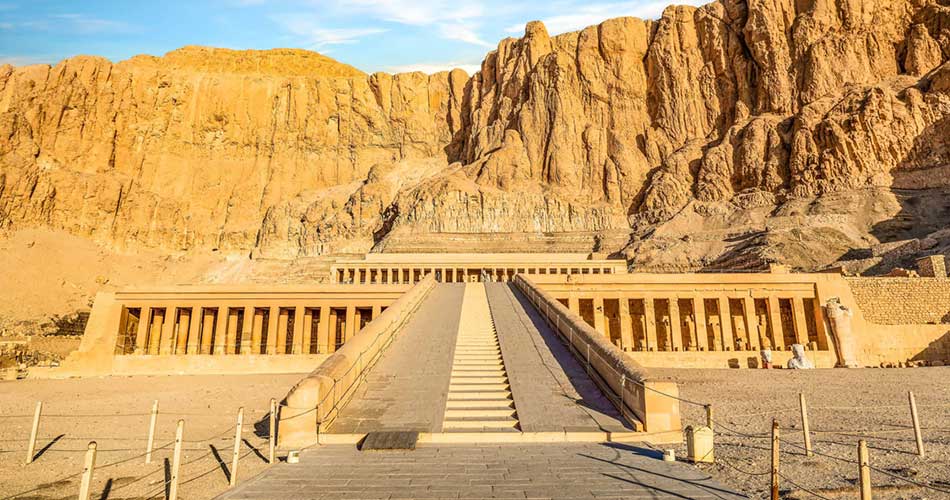Hatshepsut Temple, also known as the Temple of Deir el-Bahri, is an ancient Egyptian temple complex
Hatshepsut Temple located on the west bank of the Nile River in Luxor, Egypt.
Hatshepsut Temple was built during the reign of the 18th dynasty pharaoh, Hatshepsut, in the 15th century BC. The temple is one of the most impressive and well-preserved examples of ancient Egyptian architecture, and it is renowned for its grandeur and beauty.
Hatshepsut Temple was designed by the architect Senenmut and was built in three levels, with each level being connected by a long ramp. The lower level is dedicated to the god Amun, while the middle level is dedicated to Hathor, the goddess of love, music, and joy. The upper level is dedicated to the pharaoh herself and features an enormous courtyard, several chapels, and a sanctuary.
One of the most striking features of the temple is its unique architecture. Hatshepsut Temple is built into a cliff face, and its façade is decorated with intricate reliefs and sculptures depicting various scenes from the life of Hatshepsut and her reign. The temple’s design is a testament to the creativity and skill of the ancient Egyptian architects and builders who were able to construct such a magnificent structure without the use of modern technology.
The temple is also notable for the many statues and reliefs that adorn its walls. These features depict various scenes from the life of Hatshepsut, including her birth, coronation, and reign. One of the most famous statues is the sphinx of Hatshepsut, which stands at the entrance to the temple and features the head of the pharaoh and the body of a lion.
Despite its grandeur and beauty, Hatshepsut Temple was abandoned after the death of Hatshepsut and fell into disrepair over the centuries. It was rediscovered in the 19th century by the French archaeologist Jean-Francois Champollion, who was able to decipher the hieroglyphs on the temple’s walls and learn more about the life of Hatshepsut and her reign.
Today, the Hatshepsut Temple is one of the most popular tourist attractions in Egypt. Visitors from all over the world come to marvel at the temple’s impressive architecture and learn more about the ancient Egyptian civilization. The temple has also been designated a UNESCO World Heritage Site, which ensures its protection and preservation for future generations.
Hatshepsut was one of the most successful and influential pharaohs of the New Kingdom period in ancient Egypt. She ruled for over 20 years and oversaw a period of great prosperity and expansion for Egypt. Hatshepsut was known for her ambitious building projects, including the construction of the Hatshepsut Temple, which was intended to serve as a grand mortuary temple for the pharaoh and a place of worship for the gods.
The temple’s location on the west bank of the Nile River was significant as it was believed to be the entrance to the underworld, where the pharaohs and the gods resided. The temple was designed to be a place of worship and a site for the performance of religious ceremonies, as well as a monument to Hatshepsut’s own power and achievements.
The temple’s reliefs and sculptures are among its most impressive features. They depict various scenes from Hatshepsut’s life, including her birth, coronation, and reign. Some of the most famous reliefs depict Hatshepsut’s expedition to the land of Punt, a mysterious and exotic place believed to be located somewhere along the Red Sea coast of Africa. The reliefs show the queen and her entourage interacting with the people of Punt, exchanging gifts, and bringing exotic animals and plants back to Egypt.
The temple’s statuary is also noteworthy. The most famous statue is the sphinx of Hatshepsut, which stands at the entrance to the temple. The statue is carved from a single block of red granite and features the head of the pharaoh and the body of a lion. The sphinx was intended to symbolize the pharaoh’s strength and power and to guard the entrance to the temple.
The temple’s architecture is equally impressive. The temple is built into the side of a cliff, which provides a dramatic backdrop for the temple’s façade and courtyard. The temple is also notable for its use of ramps, which were used to connect the three levels of the temple and allowed for the easy movement of people and goods throughout the complex.
Despite its grandeur and importance, the Hatshepsut Temple was abandoned after the pharaoh’s death and fell into disrepair over the centuries. It was also damaged by earthquakes and floods, which further degraded the temple’s structure. It was not until the 19th century that the temple was rediscovered and restored by archaeologists and conservationists.
Today, the temple is one of the most popular tourist attractions in Egypt and attracts visitors from all over the world. It is also an important site for the study of ancient Egyptian civilization and religion, providing valuable insights into the beliefs and practices of this fascinating culture. Its designation as a UNESCO World Heritage Site ensures its protection and preservation for future generations, ensuring that the legacy of Hatshepsut and the ancient Egyptians will continue to be celebrated and studied for years to come.



